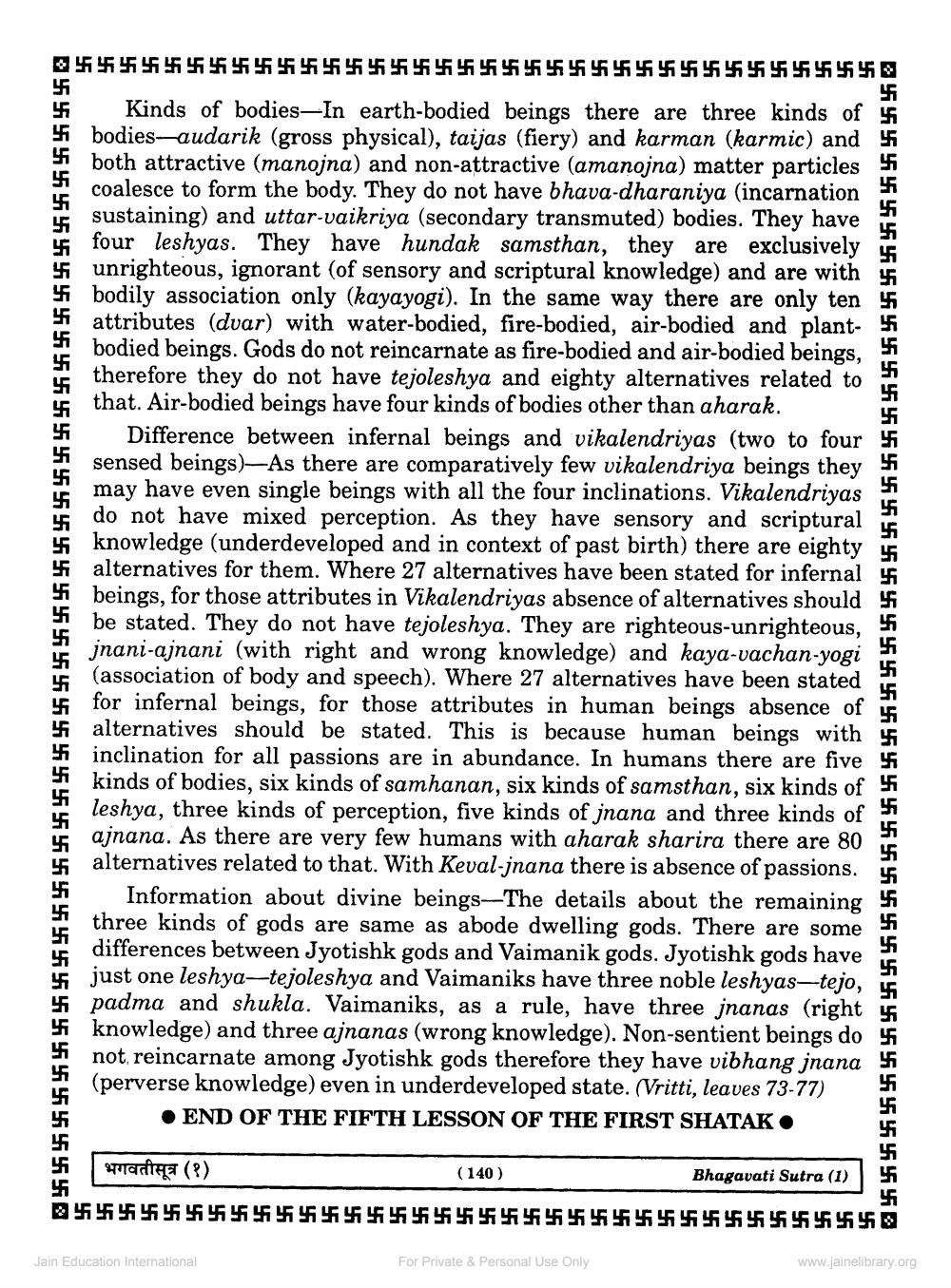________________
8555555555555555555555555555555555555
457 454 455 456 457 41 451 455 456 452
57 458 454 455 456
4 Kinds of bodies-In earth-bodied beings there are three kinds of
bodies-audarik (gross physical), taijas (fiery) and karman (karmic) and 1 both attractive (manojna) and non-attractive (amanojna) matter particles i
coalesce to form the body. They do not have bhava-dharaniya (incarnation sustaining) and uttar-vaikriya (secondary transmuted) bodies. They have four leshyas. They have hundak samsthan, they are exclusively unrighteous, ignorant (of sensory and scriptural knowledge) and are with bodily association only (kayayogi). In the same way there are only ten attributes (dvar) with water-bodied, fire-bodied, air-bodied and plantbodied beings. Gods do not reincarnate as fire-bodied and air-bodied beings, therefore they do not have tejoleshya and eighty alternatives related to that. Air-bodied beings have four kinds of bodies other than aharak.
Difference between infernal beings and vikalendriyas (two to four sensed beings)-As there are comparatively few vikalendriya beings they si may have even single beings with all the four inclinations. Vikalendriyas do not have mixed perception. As they have sensory and scriptural knowledge (underdeveloped and in context of past birth) there are eighty
alternatives for them. Where 27 alternatives have been stated for infernal i 41 beings, for those attributes in Vikalendriyas absence of alternatives should i
be stated. They do not have tejoleshya. They are righteous-unrighteous, jnani-ajnani (with right and wrong knowledge) and kaya-vachan-yogi (association of body and speech). Where 27 alternatives have been stated
for infernal beings, for those attributes in human beings absence of i alternatives should be stated. This is because human beings with $ inclination for all passions are in abundance. In humans there are five i
kinds of bodies, six kinds of samhanan, six kinds of samsthan, six kinds of $ leshya, three kinds of perception, five kinds of jnana and three kinds of 5 ajnana. As there are very few humans with aharak sharira there are 80 alternatives related to that. With Keval-jnana there is absence of passions.
Information about divine beings-The details about the remaining three kinds of gods are same as abode dwelling gods. There are some differences between Jyotishk gods and Vaimanik gods. Jyotishk gods have just one leshya-tejoleshya and Vaimaniks have three noble leshyas--tejo, in padma and shukla. Vaimaniks, as a rule, have three jnanas (right knowledge) and three ajnanas (wrong knowledge). Non-sentient beings do not reincarnate among Jyotishk gods therefore they have vibhang jnana (perverse knowledge) even in underdeveloped state. (Vritti, leaves 73-77)
• END OF THE FIFTH LESSON OF THE FIRST SHATAK •
457 454 455 456 454 455 456 457 454 455 456 4
456 455 456 457 454 455 456 457 454 455
Trade (?)
(140)
Bhagavati Sutra (1)
0441 41 41 41 41 41 41 41 41 41 41 41 41 41 41 41 41 41 41 41 41 41 41 41 41 41 41 41414141414151612
Jain Education International
For Private & Personal Use Only
www.jainelibrary.org




